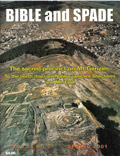
This article was first published in the Spring 2001 issue of Bible and Spade. It has been slightly edited, March 2010.
After the crucifixion, Jesus’ corpse was probably laid in a shallow grave, covered with dirt, and subsequently eaten by wild dogs—the story of Jesus’ entombment and resurrection was the result of wishful thinking (Crossan 1994:154).
Believe it or not, this provocative quote comes from a highly influential scholar who claims the Christian faith by the name of John Dominic Crossan of the Jesus Seminar. No doubt you have seen the spate of television programs and newsmagazine articles in recent years generated by Crossan and his fellow Seminar scholars with such headlines as “The Real Jesus” or “The Historical Jesus.”
At Easter time you may have unique opportunities to share your faith with others who otherwise pay little attention to the Christian creed. Are you prepared to provide them reason to believe? After all, Peter exhorts us to ‘“always be ready to make a defense” of our faith (1 Pt 3:15).
Though the Jesus Seminar espouses radical views and only represents a small minority of scholars, it has been my experience that much of America implicitly accepts its presuppositions. How many times have you heard “I believe Jesus was a great teacher or moral leader but not the Son of God,” or something similar?
The major assumption of the Seminar (and, I would contend, America at large) is that the Gospels are not historically reliable accounts. The stories handed down to us are the product of myth and legend embellished by later writers long after Jesus was crucified and buried. (They do believe He was crucified!)
Allow me briefly to examine several aspects of the New Testament that place it on a solid foundation of historical reliability. They will demonstrate that the theory of its mythology is itself fanciful and unsustainable.
The first evidence is the number of surviving New Testament manuscripts from antiquity. The oldest yet recovered is the John Rylands Fragment containing five verses from John 18. It is on a small piece of papyrus dated paleographically to about AD 125. This places it within a generation of the traditional date of the death of its author, the Apostle John! Our earliest complete New Testament books date from about AD 200 and the first complete New Testament is dated between AD 325–350. The total count of Greek manuscripts now numbers over 5,000. There is no other book from antiquity that comes anywhere near this abundance.
The second noteworthy aspect of these documents is the interval of time between their original composition and the earliest known copies. When compared to any other ancient book, the New Testament is vastly superior. It has a fragment within one generation and whole books within 200 years or so. The average gap for other works of antiquity is over 1,000 years!
Thirdly, the degree of accuracy of the copies is greater for the New Testament than for other books that can be compared. Most other books fail to survive with enough copies to make comparison possible. Of the 20,000 or so lines in the New Testament only 40 are in doubt. These “variants” are of minor consequence and do not jeopardize any doctrine of the church. This equates to an accuracy of 99.5 percent!
Finally, there is compelling evidence regarding when these books were first composed. Internal Biblical evidence and extra-Biblical data led New Testament scholar J.A.T. Robinson to say that the books therein “were coming into being more or less concurrently in the period between 40 and 70” (1976:352).
Add to this the fact that virtually all of the writers died as martyrs (Most of the original 12 apostles as well as the apostle Paul were killed for their faith) and we have a powerful testimony. Would you knowingly die for a lie?
Yes, we Christians have strong reasons to believe. Paul foretold of those like the Jesus Seminar when he wrote of men “always learning but never able to come to the knowledge of the truth” (2 Tm 3:7). Of course, the faith that saves can only come by way of the Holy Spirit. But as Blaise Pascal, the great French physicist and philosopher once wrote:
God has given evidence which is sufficiently clear for those with an open mind and an open heart, but which is sufficiently vague so as not to compel those whose hearts are closed (as quoted by William Craig in Copan 1998:57).
Let us all thank God for the many reasons He has given us to believe; reasons that can give hope and even open the hearts of unbelievers.
Bibliography
Copan, P., ed.
1998 Will the Real Jesus Please Stand Up? A Debate Between William Lane Craig and John Dominic Crossan. Grand Rapids MI: Baker.
Crossan, J.D.
1994 Jesus: A Revolutionary Biography. San Francisco: Harper.
Robinson, J.A.T.
1976 Redating the New Testament. Philadelphia: Westminster.